Cray fishing is a thrilling activity that can be enjoyed by the whole family. Cray fish (also spelled crayfish) and is known scientifically as Panulirus Cygnus, is a part of the spiny lobster family. This species is prominent over the west coast of Australia.
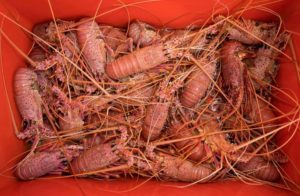
In this blog post, you will learn more about crayfish, how and where to catch, and some lovely recipes to enjoy its meat.
Crayfish Facts
Crayfish is often confused with lobster. In reality, these two species are not entirely different. The main distinction is that crayfish lives in freshwater while lobster thrives in saltwater. Western Australia has the western rock lobster, which the locals often call “crays,” which is not the correct term at all. However, the name has been around since time immemorial, so it is virtually impossible to change it. Crayfish are often referred to as rock lobster all over the country.
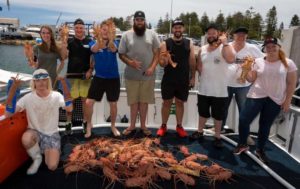
According to the Department of Primary Industries and Regional Development, cray fishing is permitted all year round. However, there are some rules and regulations to observe, which we will talk about later in this blog.
Rock lobster or crayfish have strong, tough shells. However, these shells can easily be damaged. If you break their antennae or leg off upon catching them, you lower their chance of surviving in the wild. It is best to try for crustaceans that you’re sure will be according to the rules. If you catch one that is not legal, make sure that you put it back where it came from.
Types of Crayfish
Australia is where you will find a wide variety of crayfish. As mentioned, western rock lobster is mostly found in WA, making it easy to distinguish the species from others. If there is one type of crayfish that is usually thought to be western rock lobster, it would be the southern rock lobster. Here are some unique characteristics of the two:
- Western rock lobster has a distinct look because of its two prominent horns growing on the forehead. These horns extend beyond the front of the head. This rock lobster’s body can be red or brown, and the shape is similar to that of a lobster. After shedding the exoskeleton, this lobster will look very pale, which is why it’s called a “white.” Most people catch western rock lobster at less than two kilograms, but it can reach five kilograms. This species has a white dot on the lateral or outside edge of the tail segment.
- Scientifically known as Jasus edwardsii, Southern rock lobster is also called the red rock lobster or spiny rock lobster. It is usually found in southern Australian waters, as well as the Chatham Islands in New Zealand. It can exceed eight kilograms when living in underfished sites. If the lobster you caught has a single spine that runs from between the eyes to the centre of the body, it is a southern rock lobster.
Apart from the two mentioned species above, Australia has over 100 more. Other known types are:
- The Tasmanian giant freshwater crayfish found in northern Tasmania rivers
- The Murray crayfish, found mostly in the Murray-Darling Basin
- Marron in WA where one of its two species currently tagged as endangered
The common yabby, red-claw crayfish, and western yabby are also quite popular.
Guide to Catching Crayfish
Before you try catching crayfish, you must obtain a licence first, whether you are fishing recreationally or commercially. Having a licence for recreational fishing does not entitle you to sell or use the crustacean. You should never get anything in return, including a benefit or reward from barter and exchange.
With the licence, however, you are allowed to catch eight rock lobster daily. You cannot acquire more than four tropical rock lobster species, namely the Ornate and Painted (green) rock lobsters. If you’re fishing on a boat with other people, you are allowed to take up to 24 lobsters. Bear in mind that this limit only applies if there are at least three licence holders on the boat with you.
Here are other rules that you must adhere to when fishing for crayfish in Western Australia:
- Minimum Legal Size: Upon catching western rock lobster, you should ensure it measures at least 76mm. The same requirement applies to tropical rock lobster. For southern rock lobster, it should be at least 98.5mm.
- Measurement: If it is either western or tropical rock lobster, place the tail of the gauge on top of the ridge between the lobster’s spikes at the head. The other end should be over the back of the carapace or shell. Meanwhile, if it is a southern rock lobster, measure it from the groove at the end of the antennae at the front part of the head. The other end of the gauge should be over the back of the carapace.
- Maximum Bag Size: If you catch more than eight rock lobsters or four tropical rock lobsters, you should carefully release the excess. You cannot return to shore or back to your boat if you have more than the allowed bag limit.
Females: Back in the day, female western rock lobsters had a maximum legal size limit. This limit has been lifted, but no one is permitted to catch females with eggs. You cannot remove their eggs so you could take the lobster with you. If there are any signs of breeding, such as females in berry or sitting with the tail curled under, you should set them free, as well. Berrying means they are carrying eggs. A female ready to spawn has a black spot or tar spot found under the carapace right between the back legs. You cannot catch tar spot females.
- Freeing: If you have exceeded the limit, caught a female with eggs, or taken a smaller lobster, you are required by law to return it to the water within five minutes. If you’re using a cray pot, you should let it go before pulling the next pot.
- Diving Rules: Diving can only catch lobster using a blunt crook, snare, or by hand. Anything else, including a net or spear, is considered illegal.
- Pot Limits: A licence holder can only have two rock lobster pots with a maximum of six pots per boat as long as there are at least three licenced fishers on board. Only licence holders can set and pull the pots. Sharing is allowed, provided that boat fishers carry permits.
- Pot Specifications: A put should not be more than 1,000mm at its widest point. It should only be within 500mm in height. There should only be one entrance gap. The neck of the pot should at least be 160mm wide and be rigid. No internal chambers should be found, and escape gaps should be unobstructed. If you’re fishing in the North of North West Cape, the pot does not require an escape gap. However, if fishing between Cape Leeuwin and North West Cape, the pot should have three or more escape gaps.
- Baits: Bovine material, such as skin or hide except for tallow or gelatine, cannot be used.
Always check the local guides to ensure you adhere to the existing rules.
When you’re ready to catch crayfish or rock lobster, here are some tips for successful fishing:
1. Best Spots
You can catch crayfish in the north, particularly from Exmouth to Augusta in the south. For the best luck, head to Geraldton and Perth, which have the highest rock lobster populations in the state. These crustaceans are found in both offshore and inshore reefs. If you would like to catch bigger-sized lobsters, you will most likely see them inside caves, under ledges, and in deeper offshore reefs.
3. Diving
You can catch crays using a loop (snare) or by hand. It’s a great challenge indeed, and many fishers have developed their skills in chasing after crayfish with a single breath of air. There are a few ways that will help you catch crays while diving but the most important is to wear a comfortable wetsuit with a hood.
Have a black silicone mask, gloves, neoprene socks, and closed heel fins. Your weight belt should bear the correct weight so that you can be positively buoyant when on the surface. At the same time, it should let you glide to the bottom.
You need to know the habits and movements of crays, which depend on the season. The best time is typically at the start of the season since they are easy to find in the shallow waters near the Rottnest, Carnac, and Garden Islands. Spot them in low limestone ledges, usually off the shores.
If you’re fishing in the middle of December, be prepared to dive into deeper water. Rotto is the most suitable place until the end of the year. If you want them close to the shore, pick around late February to early March.
4. Potting
There are three potting options, namely:
- Timber, which makes cray pots heavy and difficult to move or roll, but is expensive and may not be fit for small boats
- Plastic, which is inexpensive and easy to set up, but is light and unsuitable for rough waters
- Metal, which allows for easy storage but often requires extra ballast because of its lightness
Whichever pot material you select, it should not move. It’s why heavy pots, particularly timber, is best for catching crays. You will need to rig your pot using specific objects, including floats, ballast, and a weight attached to a rope (11mm pot line). For your bait, you’re allowed to use oily baits, blue mackerel, and tuna heads. Use only fresh bait.
Keeping and Eating Your Catch
If you decide to keep your catch, ensure that you clip at least the bottom half of the central flap of the tail fan. Alternatively, you can punch a 10mm-diameter hole in the centre of the tail fan. Do the clipping or hole-punching within five minutes of taking the lobster to your boat or land. That way, fisheries compliance officers can distinguish it as a recreationally caught lobster. It means you’re not allowed to sell it.
Rock lobster from WA is renowned for their beautifully textured white flesh, which is so flavourful. Once caught, it is best to cook and consume them as quickly as possible. If you plan to eat it after a few days or months, you will need to care for it, which is not exactly easy to do. The crays typically survive for hours after catching. Make sure you have adequate storage ready and never store it with occy and squid.
Crayfish with your favourite homemade seafood sauce, consisting of cream, Worcestershire sauce, lemon, and tomato sauce, is just one of the popular ways to consume it. Keep it simple because crayfish has a delicate flavour, easily overshadowed by excessive garnishes.
South American-style crayfish is considered fancy. It’s flamed with brandy, lit with brandy cream sauce with chilli and lime juice. A crayfish sandwich between pieces of fluffy white bread, seafood cocktail sauce, and iceberg lettuce is another way to enjoy your catch. For a simpler dish, a smoky barbecued rock lobster is a sure-fire treat.
And this barbecue method is usually done in the oven. Cut the crayfish in the middle, place it on the baking dish, and chuck the barbecue butter sauce on top. This sauce consists of butter, cayenne pepper, and Worcestershire sauce. Add some lemon zest and 10 or more cloves of minced garlic. Cook it in the oven for about 20 to 22 minutes. Then, roll up your sleeves and enjoy that delicate, juicy taste.

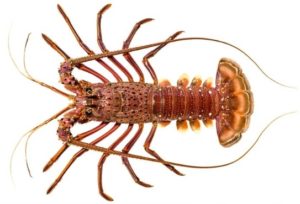
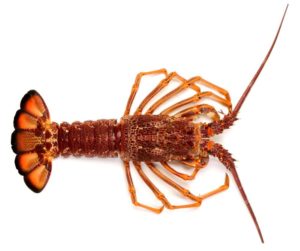
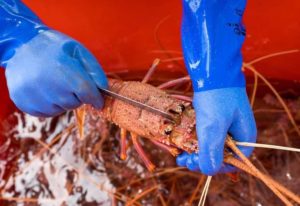
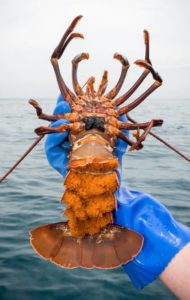 Females: Back in the day, female western rock lobsters had a maximum legal size limit. This limit has been lifted, but no one is permitted to catch females with eggs. You cannot remove their eggs so you could take the lobster with you. If there are any signs of breeding, such as females in berry or sitting with the tail curled under, you should set them free, as well. Berrying means they are carrying eggs. A female ready to spawn has a black spot or tar spot found under the carapace right between the back legs. You cannot catch tar spot females.
Females: Back in the day, female western rock lobsters had a maximum legal size limit. This limit has been lifted, but no one is permitted to catch females with eggs. You cannot remove their eggs so you could take the lobster with you. If there are any signs of breeding, such as females in berry or sitting with the tail curled under, you should set them free, as well. Berrying means they are carrying eggs. A female ready to spawn has a black spot or tar spot found under the carapace right between the back legs. You cannot catch tar spot females.